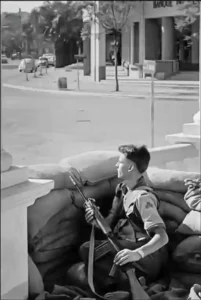In this article we look at the killing of Trooper Edward Gaffney, C Company 35 Infantry Battalion in action during Operation Morthor and the first Irish personnel who were captured by the Gendarmerie
Trooper Edward Gaffney
Today we remember the 60th anniversary of the death of Trooper Edward Gaffney, C Company, 35 Infantry Battalion ONUC who was killed on 13th September 1961 in Elisabethville in the Republic of the Congo. He was killed instantly by machine gun fire from a Gendarmerie Staghound armoured car that was crewed by mercenaries. At 1215 hours a patrol of nine personnel under the command of Sergeant George Shaughnessy travelled in two trucks bringing ammunition and other supplies from the Kasenga Tunnel to the Brigade Reserve at Albert Park. Trooper Gaffney was driving the first vehicle on Churchill Avenue and he was killed in the cab. The gendarmerie then set the truck on fire. Trooper Gaffney was twenty two years of age, he came from Norristown, Camolin, County Wexford and his home unit was 1 Armoured Car Squadron.
Operation Morthor
Operation Morthor commenced at 0400 hours on 13 Sep. 2 Platoon and 3 Platoon, C Company plus the Mortar section were tasked to seize and hold the Kasenga Tunnel at Chavssee de Kasenga (known as the Tunnel). The Gendarmerie counterattacked almost immediately with mortars and sniping. This action has been called the First Battle of the Tunnel; 36 Infantry Battalion fought in the Second Battle of the Tunnel in December 1961.
C Company 35 Infantry Battalion personnel holding the Tunnel manned trenches from the start of Operation Morthor on 13 Sep until they were relieved by B Company on 18 Sep, and the two Companies rotated each week thereafter.  During this time, they were under fire from Gendarmerie mortars, medium machine guns, rifles and armour cars, this firing was intense up to 15 Sep and it was sporadic up to 21 Sep when a ceasefire agreement came into effect. On 15 Sep, the Fouga jet dropped bombs or rockets on the positions at the Tunnel and no injuries were suffered.
During this time, they were under fire from Gendarmerie mortars, medium machine guns, rifles and armour cars, this firing was intense up to 15 Sep and it was sporadic up to 21 Sep when a ceasefire agreement came into effect. On 15 Sep, the Fouga jet dropped bombs or rockets on the positions at the Tunnel and no injuries were suffered.
1 Platoon C Company minus one section was tasked to seize and hold College St Francois De Sales (known as the Radio College), the other section secured the Factory Camp. Around 1200 hours the platoon minus at the Radio College was reduced to section strength as personnel were withdrawn, some were redeployed to guard the Italian-run UN Hospital where casualties from the fighting and from the earlier attacks by mobs were being treated.
Heavy fighting continued across the city throughout the night of 13 Sep as UN positions came under attack.
Hostages
At 1600 hours on 14 Sep, Lieutenant Tom Ryan, (Platoon Commander 1 Platoon) was guarding the Radio College with one Sergeant, two Corporals and Seven Privates, they had one Bren Light Machine Gun. He was approached by a French mercenary in civilian attire along with a priest. They knew the strength of the Irish guard at the Radio College was eleven and they had details of their weapons. The showed him one Gendarmerie armoured car and a jeep on the street with a recoilless rifle covering the college, at a signal from the mercenary, armed whites in civilian attire and uniformed Gendarmerie appeared from firing positions in the surrounding buildings. Lt Ryan was forced to surrender in the face of overwhelming opposition. The eleven C Company personnel were the first 35 Battalion personnel to be captured by the Gendarmerie and held as hostages.
While the names of those who surrendered at Jadotville have been in the public domain, little has been written about the Radio Station prisoners. They were Lieutenant Tom Ryan, Sergeant J O’Driscoll, Corporals M Conway and A Colclough, Privates W Browne, E Donohue, T Daly, J Doyle, C Doolan, P Moriarty and M Moran, 3 Infantry Battalion was the parent unit of all the enlisted personnel. They were joined in captivity by personnel from the Cahalane Patrol on 15 Sep.
They were held initially at a farm southeast of Elisabethville, on 16 Sep they were moved further south to Munama near the border with Northern Rhodesia and about 30 Km from Elisabethville.
On 18 Sep, an officer and five enlisted personnel from the Italian Hospital were taken prisoner at the Italian Stores Depot in Elisabethville and they were brought to Munama. The Irish and Italian prisoners were guarded by between sixty and eighty Paracommandos who were commanded by a French mercenary Captain. On the night of 21 – 22 Sep the prisoners were moved to Briqueville. On the following day they were driven on an eighth hour journey to Jadotville where they joined the A Company hostage.
On 25 Oct, the C Company hostages and other UN personnel were released at the Old Air Strip in Elisabethville in exchange for Gendarmerie and Katangese police who had been captured by the UN.

